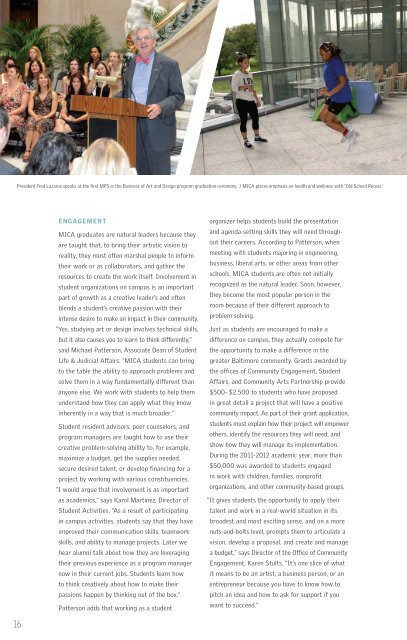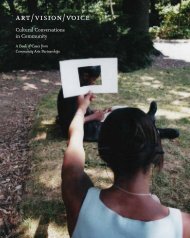They make a way. - Maryland Institute College of Art
They make a way. - Maryland Institute College of Art
They make a way. - Maryland Institute College of Art
You also want an ePaper? Increase the reach of your titles
YUMPU automatically turns print PDFs into web optimized ePapers that Google loves.
President Fred Lazarus speaks at the first MPS in the Business <strong>of</strong> <strong>Art</strong> and Design program graduation ceremony. / MICA places emphasis on health and wellness with “Old School Recess.’<br />
16<br />
ENGAGEMENT<br />
MICA graduates are natural leaders because they<br />
are taught that, to bring their artistic vision to<br />
reality, they must <strong>of</strong>ten marshal people to inform<br />
their work or as collaborators, and gather the<br />
resources to create the work itself. Involvement in<br />
student organizations on campus is an important<br />
part <strong>of</strong> growth as a creative leader’s and <strong>of</strong>ten<br />
blends a student’s creative passion with their<br />
intense desire to <strong>make</strong> an impact in their community.<br />
“Yes, studying art or design involves technical skills,<br />
but it also causes you to learn to think differently,”<br />
said Michael Patterson, Associate Dean <strong>of</strong> Student<br />
Life & Judicial Affairs. “MICA students can bring<br />
to the table the ability to approach problems and<br />
solve them in a <strong>way</strong> fundamentally different than<br />
anyone else. We work with students to help them<br />
understand how they can apply what they know<br />
inherently in a <strong>way</strong> that is much broader.”<br />
Student resident advisors, peer counselors, and<br />
program managers are taught how to use their<br />
creative problem-solving ability to, for example,<br />
maximize a budget, get the supplies needed,<br />
secure desired talent, or develop financing for a<br />
project by working with various constituencies.<br />
“I would argue that involvement is as important<br />
as academics,” says Karol Martinez, Director <strong>of</strong><br />
Student Activities. “As a result <strong>of</strong> participating<br />
in campus activities, students say that they have<br />
improved their communication skills, teamwork<br />
skills, and ability to manage projects. Later we<br />
hear alumni talk about how they are leveraging<br />
their previous experience as a program manager<br />
now in their current jobs. Students learn how<br />
to think creatively about how to <strong>make</strong> their<br />
passions happen by thinking out <strong>of</strong> the box.”<br />
Patterson adds that working as a student<br />
organizer helps students build the presentation<br />
and agenda-setting skills they will need throughout<br />
their careers. According to Patterson, when<br />
meeting with students majoring in engineering,<br />
business, liberal arts, or other areas from other<br />
schools, MICA students are <strong>of</strong>ten not initially<br />
recognized as the natural leader. Soon, however,<br />
they become the most popular person in the<br />
room because <strong>of</strong> their different approach to<br />
problem solving.<br />
Just as students are encouraged to <strong>make</strong> a<br />
difference on campus, they actually compete for<br />
the opportunity to <strong>make</strong> a difference in the<br />
greater Baltimore community. Grants awarded by<br />
the <strong>of</strong>fices <strong>of</strong> Community Engagement, Student<br />
Affairs, and Community <strong>Art</strong>s Partnership provide<br />
$500- $2,500 to students who have proposed<br />
in great detail a project that will have a positive<br />
community impact. As part <strong>of</strong> their grant application,<br />
students must explain how their project will empower<br />
others, identify the resources they will need, and<br />
show how they will manage its implementation.<br />
During the 2011-2012 academic year, more than<br />
$50,000 was awarded to students engaged<br />
in work with children, families, nonpr<strong>of</strong>it<br />
organizations, and other community-based groups.<br />
“It gives students the opportunity to apply their<br />
talent and work in a real-world situation in its<br />
broadest and most exciting sense, and on a more<br />
nuts-and-bolts level, prompts them to articulate a<br />
vision, develop a proposal, and create and manage<br />
a budget,” says Director <strong>of</strong> the Office <strong>of</strong> Community<br />
Engagement, Karen Stults. “It’s one slice <strong>of</strong> what<br />
it means to be an artist, a business person, or an<br />
entrepreneur because you have to know how to<br />
pitch an idea and how to ask for support if you<br />
want to succeed.”
















